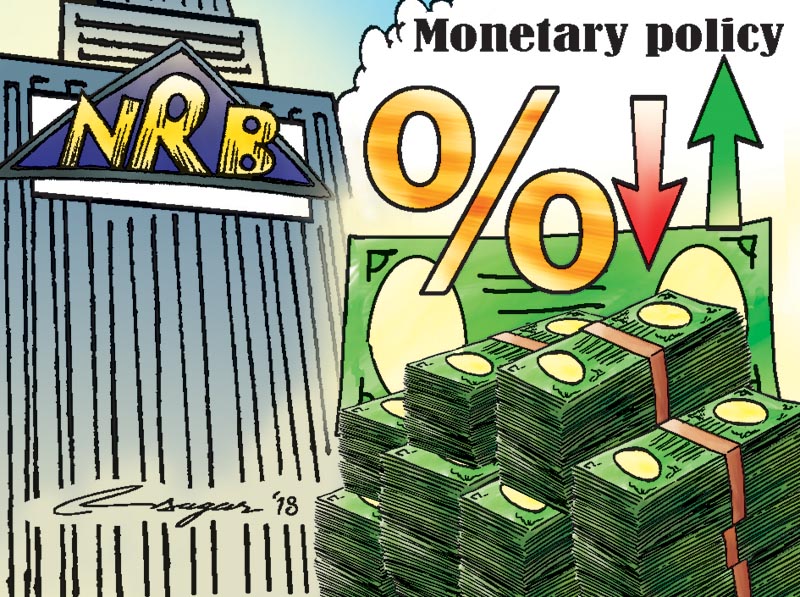New monetary policy: Is it aimed at IR stability?
An intentional lowering of interest rate cannot promote financial stability; rather it amplifies the volatility of inflation and economic growth. A self-correcting mechanism is necessary in the free market economy
Nepal Rastra Bank (NRB) recently unveiled the monetary policy for the fiscal year 2018-19. In the context that Nepali financial system is now realising a higher rate of interest and lower availability of loanable fund, stakeholders and experts were keenly waiting for the monetary policy.
As per the expectations, the NRB has taken all the measures it can to address the concerns through the monetary policy by using the possible instruments in hand.
To ease the market liquidity and lower the base rate, the NRB has taken a bold step by lowering the cash reserve ratio (CRR) and statutory liquidity ratio (SLR) set for commercial banks by two percentage points. Likewise, the NRB has lowered the bank rate in which central bank lends the counter-parties as a lender of last resort facility. These measures are expected to ease the market liquidity further and lower the base rate so as to decrease the long-term interest rates.
In addition, the NRB has narrowed down the width of the interest rate corridor: a floor and ceiling rate between liquidity withdraw and inject from 4 per cent to 3 per cent. The two weeks’ deposit collection rate is raised to 3.5 per cent while the standing lending facility (SLF) rate has been lowered to 6.5 per cent. The convention is: the lower the width of the corridor, the lower the incentive to hold liquidity by the banks. Also, a narrow corridor provides incentives to lower the interest rate spread to the financial intermediaries.
Further to this, some financial sector policies such as less flexibility in fixed-deposit auction rate, tightening on single institutional deposit, and lowering the interest rate spread from existing 5 per cent to 4.5 per cent, are some of the measures undertaken so far. All these monetary and financial measures are thus targeted for lowering the lending rate. These steps are observed as the most optimal monetary measures the NRB has in hand to address both stability and growth issues of Nepali economy.
Even if those many measures introduced in the monetary policy, it is still uncertain whether the core issues of the interest rate of Nepali financial system will be addressed.
In the realm of poor transmission of monetary policy instruments to the real economy, containing the short-term interest rate may not be reflected on the long-term rate of interests. In case banks cannot mobilise the savings further, they would be unable to lend more due to other regulatory provisions such as credit to capital-deposit ratio. Furthermore, Nepal has a limited supply of deposits even in the case with much higher rate of deposit compared to foreign countries due to the restrictions on foreign deposit mobilisation. Thus, the money market, a market between deposit and lending, cannot be clear itself. The result is banks focus on raising the interest rate to manage the individual portfolio, but from the same pie. To contain this trend, some of the measures such as less flexibility in both the quantity and rate of institutional deposit collection may not be sufficient.
The notion that the banking sector is only the source of long-term investment seems problematic. As commercial banks by nature transact for short-term financial needs, depending largely upon the public deposit, such reliance on short-term resources for the long-term lending does raise some concerns about maturity mismatch. In addition, over-reliance on non-bank financial institutions as well as infrastructure companies have been creating pressure on banks when it comes to managing resources.
For example, contractual saving institutions and insurance companies have a large deposit in the commercial banks instead of direct lending to the projects. Furthermore, infrastructure development companies also are putting their money into the fixed deposit and enjoying bank interests, instead of investing in the projects. And regulator is directing banks to lend a certain portion of
their lending into the specified projects such as hydropower. Such a reverse trend needs to be corrected such that infrastructure companies aimed at developing hydropower and roads should finance the projects themselves, not that they put the deposit at banks and banks finance these projects.
Although lower interest rate discourages saving and intensifies the sub-prime lending, the higher interest rate is not desired by the market. Lower deposit rate provides enough space for investors to bargain with banks and it also increases bank’s profit.
The most vulnerable clients of both higher and lower interest rates are the general public anyway. An intentional lowering of interest rate cannot promote financial stability; rather it amplifies the volatility of inflation and economic growth. A self-correcting mechanism is necessary for the free market economy.
As Carlos Slim says, “Low interest rates are a big opportunity for investment, but the issue is that this money should go to the real economy, not the financial economy”, in the context of ballooning current account deficit and depleting foreign exchange reserves, an expansionary monetary policy may hit both price and external sector instability.
The NRB has put forward all the possible ways it has, the success of the policy depends upon the act of stakeholders, especially the implementation of fiscal policy, counter-parties and private sectors.
Bhatta is deputy director, Nepal Rastra Bank






